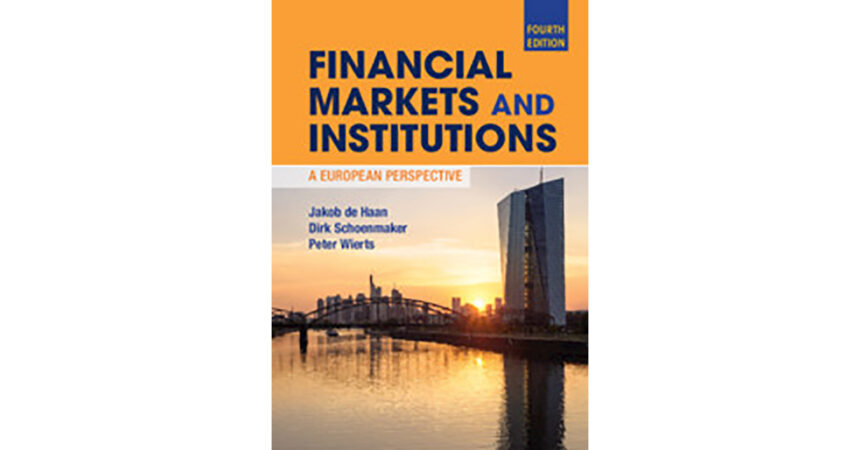Financial Markets and Institutions: A European Perspective (fourth edition). 2020. Jakob de Haan, Dirk Schoenmaker, and Peter Wierts. Cambridge University Press.
Financial Markets and Institutions: A European Perspective is intended as a university textbook suitable for advanced undergraduates and graduate students. Now in its fourth edition, it has been brought up to date in 2020 to capture recent data and to include certain financial innovations and regulatory developments.
This book can be seen as having two strands. The first is a summary of the financial markets and institutions referred to in the first half of the book’s title. The second is a very specific European perspective on these markets and institutions. Most prospective investors and CFA charterholders will be familiar with much of the material in the first strand — money, stock and bond markets, financial crises, types of investors, and the role of regulators. It is the second strand that will provide the most value to experienced market participants.

The European Union has been evolving since shortly after
World War II. The European Coal and Steel Community was established in the
early 1950s, and it was this institution that represented the first step toward
today’s integrated European institutions. Initially, there were six member
states, and that number eventually grew to 28 (before falling to 27 following
Brexit). An initial focus on trade has expanded, and the EU is now involved in
many aspects of the lives of its more than 440 million citizens. Currently, 19
member states use a common currency, the euro. The phrase “ever closer union,”
which has been in use since the 1957 Treaty of Rome, can still be seen as
something of a North Star for supporters of the European project.
The development of this European project has often been
beset by problems. A chapter on financial crises includes a review of the
European sovereign debt crisis that began in 2009. There were fears it “could
undermine the stability of the euro area and perhaps even the sustainability of
the currency union.” During this crisis, several EU member states experienced
financial distress, raising the threat of Greece exiting the EU, which was
dubbed “Grexit.” This threat would later be overshadowed by the ultimately more
real prospect of Brexit.
One difficulty facing the European Union is that decision making among its institutions can be torturous. The text’s exposition of this problem is clear and concise. The European Commission is the arm of the EU that suggests policy initiatives (through a variety of instruments, including regulations, directives, and decisions). The Council of the European Union, made up of ministers from governments of the member states, is the body that makes decisions. (This process is subject to oversight from the directly elected European Parliament.) Decisions on financial services policy usually require a “Qualified Majority” in the council, “55 per cent of council members, comprising at least 16 Member States and representing at least 65 per cent of the EU population.” Monetary policy decision making in the European Central Bank can also be difficult; votes taken by the ECB Governing Council involve 21 voting members, compared with 12 on the US Federal Reserve’s Federal Open Market Committee.

In this context, some may find it surprising just how much is achieved by these institutions. Prospective investors in Europe, including in European financial institutions, will be particularly interested in the evolution of regulation since the global financial crisis (GFC) and the euro crisis. In 2012, a decision to form a European Banking Union (BU) was made. This includes a “Single Supervisory Mechanism” that now deals with day-to-day supervision of banks and a “Single Resolution Mechanism” that is responsible for the orderly restructuring or liquidation of ailing institutions. Since 2016, insurance companies have been subject to the Solvency II Directive, which helps ensure the financial soundness of insurers and enhance the protection of policyholders. The authors make clear that the process of integrating Europe’s financial markets is incomplete and that “further integration within the BU can be expected.” Nevertheless, although prospective investors may once have perceived regulation to be uneven, they can now be confident that a standard set of rules exists for financial institutions across the EU.
It is a given that regulation is important for financial
stability and consumer protection, but regulation can also influence product
design. For example, according to the authors, “the more liberal stance of
European regulation on the use of derivatives in investment funds” has
contributed to more extensive development of synthetic exchange-traded funds in
the EU than in the United States. It would have been interesting to learn about
other cases in which differences in regulations between the two jurisdictions
led to differences in product design.

This is a textbook that deals with complex issues of
regulations and institutions. We read of a sometimes dizzying array of boards,
councils, committees, and authorities, as well as an alphabet soup of EBAs, SSMs,
ESRBs, and more. The material is always presented in a logical and digestible
manner, often brought to life through analysis of recent cases. (One good
example is the summary of investigations into fees charged by such payment
processors as Visa and Mastercard.) This reviewer would have welcomed more such
case studies. For example, further analysis of specific bank failures during
the GFC could have brought home the need for stronger supervision. Also, the
final chapter, on European Competition Policy, could have been enlivened by such
a case as the attempted merger of General Electric and Honeywell, in which
European authorities prevented the merger of two companies from outside the
bloc.
Rigorous, up-to-date, and practical, this textbook can help investors navigate the complex territory of European regulation and better understand the investment characteristics of European financial institutions.
If you liked this post, don’t forget to subscribe to the Enterprising Investor.
All posts are the opinion of the author. As such, they should not be construed as investment advice, nor do the opinions expressed necessarily reflect the views of CFA Institute or the author’s employer.








